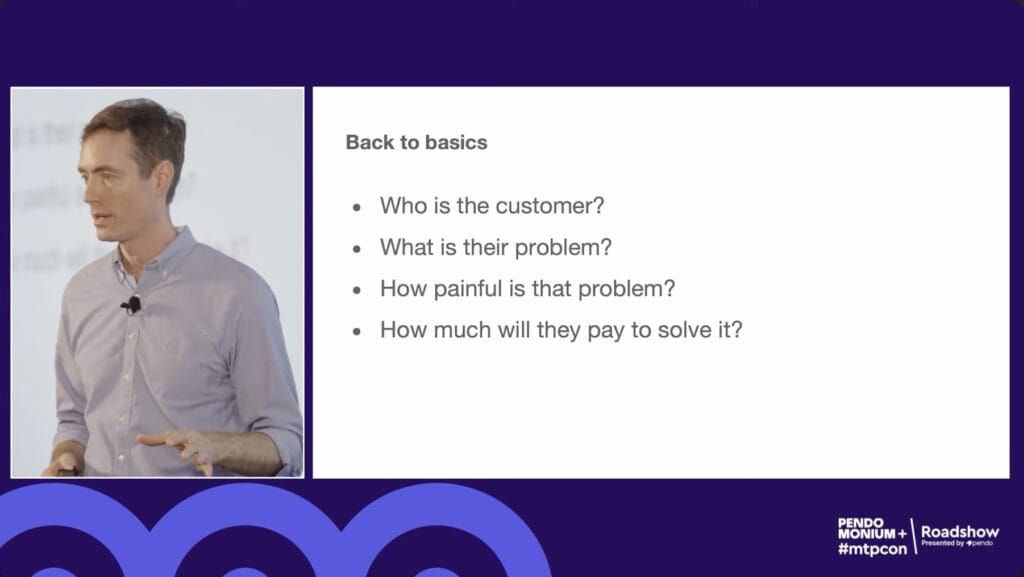Andrew Martinez-Fonts, VP of product at Honeysales, is a veteran product manager and leader with experience at companies like Yelp, eBay, Prosper, and Silver Spring Networks. He joined the Pendomonium + #mtpcon Roadshow last month to discuss AI's role in product strategy. Watch the video in full, or read on for key takeaways from his talk!
He kicked off his presentation with a question everyone has heard in the past year: “Raise your hands if any of you've had an AI chatbot try to break up your marriage?” Andrew asked the audience.
While the increasing instances of AI in our daily lives aren't slowing down, as Andrew humorously reminded us, he also stresses that "AI is a tool to make our products better, but it's not the tool that creates products."
Andrew talked about how, throughout his 20-year career, his passion for solving human-centred problems has driven him. Human-centred problems are at the root of why we make products in the first place.
While he acknowledged how valuable AI can be at solving those problems, he reminded us that AI has limitations and requires a focused product strategy.
When it comes to developing impactful product strategies, Andrew favours Gibson Biddle's methods. Biddle, a former VP of product at Netflix, breaks down the principles of product strategy with a proven framework — the DHM.
This framework, Martinez-Fonts argues, provides a solid foundation for any product strategy.
It's difficult to talk about AI without acknowledging hype's role in technology adoption and public perception of new tools. Andrew discussed the importance of understanding hype, what a “hype cycle” is, and how these cycles affect product growth. He referenced Gartner's five stages of a hype cycle:
This model provides a framework that predicts how people interact with new technology, and AI is no different, according to Andrew. He argued that AI has already gone through several hype cycles. For example:
Where are we now with AI? According to Andrew, we're on the slope of enlightenment — we're understanding AI's boundaries, what we can do with it, and how to integrate it into everyday tasks, jobs, and products.
During the AI hype, Andrew acknowledged the pressures on CEOs to figure out and ask their teams what to do about AI. While this is an important question, he wonders if it's the right question to ask ourselves.
You still need to focus on your customers. Customers have real problems. They didn't ask for AI, they asked for answers to their problems.
It always comes back to solving human problems. He encourages product managers to go back to the basics of solving customer problems by asking these questions:

A successful product strategy relies on having the answers to these questions. Only then can product experts integrate AI into a product.
Using AI at Honeysales, a seed-based startup in Berlin, required a strong product strategy foundation and a clear understanding of the team's problems and needs. Andrew used the DHM model to ensure they were on the right track and then looked at areas in their processes where AI could be useful.
While integrating AI at Honeysales, the team had several technical considerations to remember — only use high-quality data, be mindful of how fast LLMs can operate, and watch out for consistency issues.
Andrew walks through one of their consistency issues. In the German language, there are formal and informal pronouns. AI was having a problem using the correct formality of the pronouns consistently. This caused the team to revisit and rewrite their prompts, ensuring better consistency.
Another area companies must consider is the financial impact of AI tools. Andrew discusses how companies have to consider their usage frequency. Having a clear picture of query volumes helps companies decide between using ChatGPT as a hosted service or hosting their own open source LLM.
The last point he emphasises is the importance of checking the quality of AI's work. Quoting Regan's “trust but verify” phrase, Andrew reminds us that checking AI's work is inevitable and necessary. Whether it's a whole team or just one or two people, humans are ultimately responsible for the work AI produces.
In his last few slides, Andrew gave two examples of companies that are getting it right using the DHM model. According to him, Adobe Firefly and eBay's "Shop the Look" nail all three parts of the delight, hard-to-copy, and margin-enhancing model.
What do they have in common? In both cases, they leverage the ‘Delight’ and ‘Hard to copy’ parts of the DHM model in hyper-specific ways to their company and are hyper personalized to the user’s request. Both companies use AI to solve human-centered problems in a unique way.
Read more recaps from the Pendomonium + #mtpcon 2024 roadshow
















